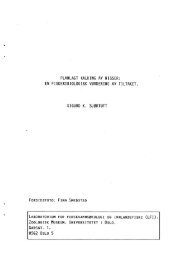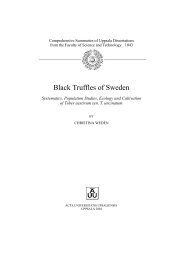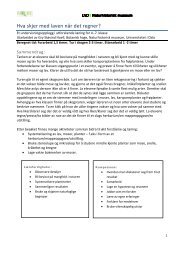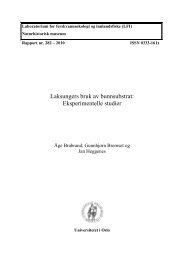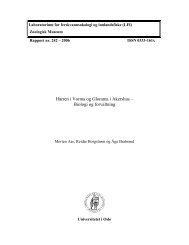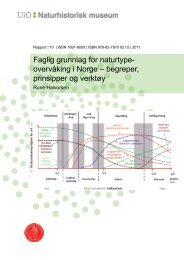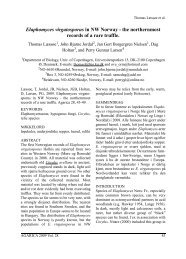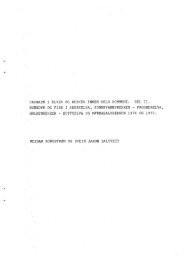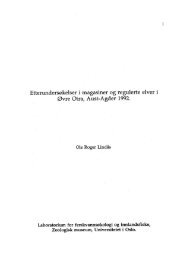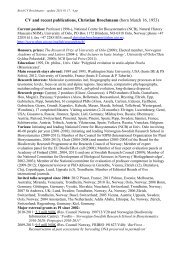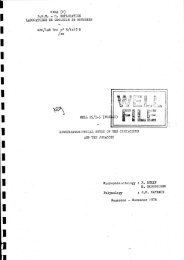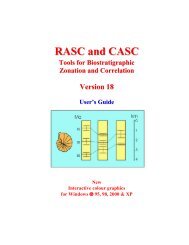Truffle trouble: what happened to the Tuberales?
Truffle trouble: what happened to the Tuberales?
Truffle trouble: what happened to the Tuberales?
- TAGS
- truffle
- www.nhm.uio.no
You also want an ePaper? Increase the reach of your titles
YUMPU automatically turns print PDFs into web optimized ePapers that Google loves.
What <strong>happened</strong> <strong>to</strong> <strong>the</strong> <strong>Tuberales</strong>? 1093<br />
and completely s<strong>to</strong>pping <strong>the</strong> production of mushrooms’. It<br />
was later found in o<strong>the</strong>r American sites and later also in<br />
Europe (e.g. Pegler et al. 1993). It resembles many typical<br />
ascomyce<strong>to</strong>us truffles in having a convoluted ascoma up <strong>to</strong><br />
3 cm diam with an outer rind. It may have one or several openings<br />
<strong>to</strong> <strong>the</strong> exterior. The asci are evanescent, long stipitate<br />
with a sac-like, spore-containing part. Unlike typical pezizalean<br />
truffles, <strong>the</strong> spores are smooth and subglobose, 5–7 mm<br />
diam, and form an ‘olivaceous sulphur-coloured dusty mass’<br />
(Diehl & Lambert 1930; Gilkey 1955). Diehl & Lambert (1930)<br />
also reported chlamydospores up <strong>to</strong> 13 mm diam, with a thick,<br />
golden-brown wall. It was grown in artificial culture, where it<br />
produced ascomata. These authors tentatively concluded that<br />
<strong>the</strong> truffle could be considered a weed in mushroom beds<br />
ra<strong>the</strong>r than a parasite of <strong>the</strong> mushrooms. Singer (1961) published<br />
a plate that clearly indicates <strong>the</strong> scale of a full-blown<br />
‘infection’ in a mushroom bed. Hawker (1959) did some developmental<br />
studies on Diehliomyces and concluded that <strong>the</strong> ascomata<br />
were not truly folded as in a typical member of <strong>the</strong><br />
<strong>Tuberales</strong>, and she supported a transfer <strong>to</strong> <strong>the</strong> Eurotiales. She<br />
found a completely irregular arrangement of <strong>the</strong> ascogenous<br />
hyphae and asci, even at very early stages of development.<br />
Currah (1985) excluded it from <strong>the</strong> Onygenales, where Benny &<br />
Kimbrough (1980) had accepted it.<br />
Excluded truffle taxa<br />
Amylocarpus Curr. 1859<br />
Type: Amylocarpus encephaloides.<br />
This monotypic genus has passive spore dispersal but develops<br />
on intertidal wood and, although originally included in<br />
<strong>the</strong> Tuberaceae, it cannot be considered a truffle in <strong>the</strong> sense of<br />
this paper. Its current position is unsettled (e.g. Landvik et al.<br />
1998). It is listed as Leotiomycetidae with unclear position in<br />
Kirk et al. (2001) and as Helotiales incertae sedis in Eriksson (2006a).<br />
General information<br />
For general information on truffles refer, for example, <strong>to</strong> North<br />
American Truffling Society (www.natruffling.org/) and e.g.<br />
Bucquet-Grenet & Dubarry (2001). A very extensive bibliography<br />
on <strong>the</strong> genus Tuber can be found in Ceruti et al. (2003).<br />
Also, Trappe & Maser (1977) and Trappe et al. (2001) should<br />
be consulted. Recently a very illustrative guide <strong>to</strong> Andalucian<br />
truffles directed at <strong>the</strong> general public has been published (Arroyo<br />
et al. 2005). Dannell (1996) published a useful popular review<br />
in Swedish.<br />
Discussion<br />
Phylogenetic relationships of truffles within Pezizales<br />
Within <strong>the</strong> last 13 y molecular phylogenetic studies have gradually<br />
confirmed and greatly expanded our knowledge on a repeated<br />
evolution of ascomyce<strong>to</strong>us truffles across Pezizales.<br />
The first study <strong>to</strong> address <strong>the</strong> controversial issue of <strong>the</strong> placement<br />
of Tuber was that of Landvik & Eriksson (1994a), who<br />
confirmed <strong>the</strong> placement within Pezizales, as predicted by<br />
Trappe (1979) and o<strong>the</strong>rs. Elaphomyces was erroneously indicated<br />
<strong>to</strong> be nested within Pezizales (Landvik & Eriksson<br />
1994a; but see Landvik & Eriksson 1994b), but was later shown<br />
<strong>to</strong> be closely related <strong>to</strong> Eurotiales and Onygenales (Landvik et al.<br />
1996). The early study by Landvik & Eriksson (1994b) showed<br />
that Glaziella, with <strong>the</strong> highly unusual ascomatal form, was<br />
nested within Pezizales. Attempts <strong>to</strong> find out <strong>the</strong> exact relationship<br />
of Glaziella have since been carried out (see Glaziellaceae<br />
above). The molecular study by O’Donnell et al. (1997)<br />
included a large number of truffles <strong>to</strong>ge<strong>the</strong>r with a large number<br />
of pezizalean epigeous taxa (from lineage B) and was <strong>the</strong><br />
first <strong>to</strong> discover multiple (at least five), independently derived,<br />
hypogeous clades within Pezizales. It resulted in new family<br />
assignments for several truffles and revealed a relationship<br />
between Tuberaceae and Helvellaceae. Percudani et al. (1999)<br />
focused on hypogeous Pezizales phylogeny and species<br />
thought <strong>to</strong> belong <strong>to</strong> <strong>the</strong> Balsamiaceae, Terfeziaceae, and Tuberaceae.<br />
Unfortunately <strong>the</strong>y included only few epigeous taxa,<br />
which resulted in Cazia, Mattirolomyces, Pachyphloeus, and Terfezia<br />
(Terfeziaceae) erroneously formed a monophyletic group<br />
within Pezizaceae. A study with a broader sampling of epigeous<br />
pezizaceous species followed (Norman & Egger 1999) that<br />
showed ‘Terfeziaceae’ are not monophyletic. The study of<br />
epigeous-hypogeous relationships within Pezizaceae was<br />
fur<strong>the</strong>r expanded (Hansen et al. 2001) and gave support for at<br />
least three independent origins of hypogeous forms within<br />
<strong>the</strong> family. Most recently, Perry et al. (2007) focusing on Pyronemataceae,<br />
with a large taxon sampling, suggested that <strong>the</strong> truffle<br />
form has arisen at least five times independently within<br />
that family. All of <strong>the</strong>se studies used regions from <strong>the</strong> nuclear<br />
ribosomal genes. One multi-locus study has emerged (Hansen<br />
et al. 2005) substantiating <strong>the</strong> evolution of truffles within Pezizaceae<br />
using combined analyses of LSU rDNA and protein-coding<br />
genes, RNA polymerase II (RPB2), and b-tubulin.<br />
Several fur<strong>the</strong>r papers dealing with <strong>the</strong> phylogeny of truffles<br />
(e.g. Diéz et al. 2002; Ferdman et al. 2005) have unfortunately<br />
only included truffles in <strong>the</strong> analyses, which have<br />
made it difficult <strong>to</strong> pinpoint epigeous relatives and fully<br />
understand <strong>the</strong>ir relationships and taxonomy. Vizzini (2003)<br />
gave <strong>the</strong> most recent review of ascomyce<strong>to</strong>us truffles.<br />
The 55 species of truffles included in <strong>the</strong> current review occur<br />
in 15 separate lineages within <strong>the</strong> Pezizales: in nine lineages<br />
within Pezizaceae (Fig 2), in three lineages within<br />
Morchellaceae–Discinaceae–Helvellaceae–Tuberaceae (Fig 3) and<br />
in three lineages within Pyronemataceae (Fig 4). The only strictly<br />
hypogeous family known is currently Tuberaceae. Table 2 gives<br />
an overview of recent classifications of pezizalean truffles and<br />
an up-<strong>to</strong>-date classification based on both molecular and<br />
morphological characters.<br />
Cy<strong>to</strong>logy<br />
The number of nuclei in mature ascospores within <strong>the</strong> Pezizales<br />
has long been considered a character of major importance<br />
in defining taxa (see e.g. Ber<strong>the</strong>t 1964; Korf 1973a,<br />
1973b and Zhang 1992a,b). It has been shown that <strong>the</strong><br />
hypogeous members of <strong>the</strong> Pezizales also tend <strong>to</strong> have <strong>the</strong><br />
same number of nuclei in <strong>the</strong> spores within a certain family<br />
or genus. Tuber is an exception, as <strong>the</strong> spores can have from<br />
one <strong>to</strong> 18 nuclei, although most species have four nuclei in<br />
each spore (Vizzini 2003). The known numbers are summarized<br />
in Table 3. Zhang (1992a) found Genea (two species),



